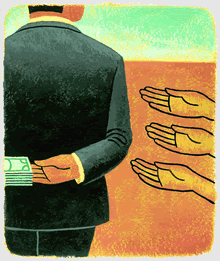 Recent innovations in methodology have sparked a remarkable expansion in economists’ ability to measure corruption. This column reviews these new techniques, which range from inferring corrupt links from stock prices to attempting to observe bribes undercover. It concludes that, while corruption is prevalent in poor countries, there remains little consensus about its magnitude or the best way to fight it.
Recent innovations in methodology have sparked a remarkable expansion in economists’ ability to measure corruption. This column reviews these new techniques, which range from inferring corrupt links from stock prices to attempting to observe bribes undercover. It concludes that, while corruption is prevalent in poor countries, there remains little consensus about its magnitude or the best way to fight it.In recent years, innovations in methodology have sparked a remarkable expansion in economists’ ability to measure corruption. New techniques, from inferring corrupt links from stock prices to attempting to observe bribes directly, have been combined with randomised controlled trials and other empirical methods not only to uncover how much corruption exists but also to suggest what policies might be effective to reduce it. The resulting literature represents a small window on a vast, hidden world of bribes and graft that follows surprisingly familiar economic rules.
See full Article.



